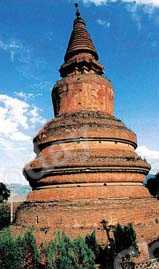
Yanmen Pass, once said to be the key to controlling China.
DAIXIAN is an ancient town in central Shanxi Province, just a few hours by expressway from Beijing. People have been living here since the New Stone Age in around 7,000 BC. Marking the border between ancient China and the northern lands of nomadic tribes, it was once a place of considerable strategic importance that witnessed many significant battles. In times of peace, it was a prosperous nexus of trade and cultural exchange between Han people and visiting northern nomads. As a result, Daixian is characterized by "Yan-men Culture," a unique blend of Han and nomadic traditions.
The term "Yanmen Culture" is derived from the town's proximity to Yanmen Pass, just 20 kilometers north of Daixian. Regarded as the most important pass along the length of the Great Wall since the Warring States Period (475-221 BC), an ancient saying reveals its significance: "If you capture Yanmen Pass, you will get the whole country - if you lose it, you will lose the whole country." It was from here that General Meng Tian, Emperor Qinshihuang's military confidant and builder of the Great Wall, led a troop of 3,000 to bravely meet the enemy head-on during the Qin Dynasty (221-206 BC). Later, many famous generals from different dynasties were garrisoned here to protect the inner lands to the south, like Xue Rengui, Guo Ziyi and Li Keyong. The extensive fortifications in the pass survived many battles, and are listed as key cultural relics under national protection, along with the section of the Great Wall that passes through here dating from the Ming Dynasty (1368-1644).

Asoka Pagoda.
One of the most famous names associated with Daixian and Yanmen Pass is the Yang family of the Northern Song Dynasty (960-1127). Yang is still a respected name in the town, as after the first Yang general died, his wife and children continued to guard Yanmen Pass and the frontier area. The family earned the admiration of locals through their devotion to maintaining peace and order on the northern border. Their descendents still live in the town today.
The Yang Ancestral Hall lies 20 kilometers east of the town and has a history stretching back 700 years. A pair of powerful lions before the main gate protect the Yang ancestors inside, while inscriptions on a plaque praise the family's loyalty and courage. In the middle of the Grand Hall stand the statues of Yang Ye, the first general of the family, and his wife Dowager She, who was also a competent general. Next to them are their eight sons. The wing-rooms are home to the statues of the family's female generals, who dashed forward when their husbands or brothers were cut down in battle.
Like the area's famous defensive structures and the Yang Ancestral Hall, the town of Daixian itself is well preserved. Formerly called Daizhou, the town's strategic position meant that in ancient times the population had to be constantly vigilant. The old town has four gates in its city walls, one for each point of the compass. Four enceintes can be found outside each gate. A fortified gatetower overlooks each of the four gates and enceintes. In addition, the city walls have four corner towers. Within these heavy outer defenses can be found dozens of temples, nunneries and shops. In the town center stands the 700-year-old Bianjing Tower, known to locals as the drum tower. In wartime, sentries were posted here and beat the drum if they saw enemy approaching.
Daixian contains two more important relics under national protection: Asoka Pagoda and the town's Confucian Temple. The first Asoka Pagoda was built of wood in 601, but the edifice we see today is a Tibetan-style brick pagoda built in 1275, featuring refined brick carving. Confucian temples can be found in almost every ancient Chinese town, but the one in Daixian still impresses visitors with its resplendent decoration and grand scale, occupying an area of 15,000 square meters. Built in the Tang Dynasty, it is the third largest Confucian temple in China, just behind the enormous temples in Beijing and Confucius' hometown Qufu.
Daixian saw a flourishing trade during the Ming (1368-1644) and Qing (1644-1911) dynasties and reached its economic peak some 200 years ago. According to county annals, by around the middle of the Qing Dynasty in the early 19th century, there were over 700 shops and 3,000 businessmen in the town. Shrewd local merchants also had business footholds in larger cities around the country.
In contemporary times, local authorities are working to revive the town's fortunes through investment in tourism. As well as the town itself, the county of Daixian boasts many tourist attractions, such as Zhaogaoguan Forest Park, Bairenyan Temple, the Tomb of Li Keyong (Prince of Jin in the late Tang Dynasty), Baiyun (White Cloud) Temple and Foguang (Glory of Buddha) Temple. Recognizing the area's great potential, the local government has raised a fund of RMB 160 million and formulated plans to make tourism an important industry. As well as stimulating the local economy, development of local visitor services will allow many more tourists from China and abroad to witness the ancient wonders of Daixian County.



 Copy Reference
Copy Reference 